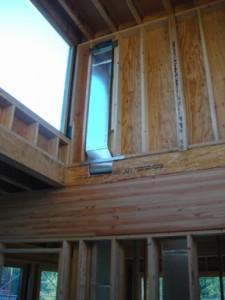 How many times have you complained about how one room is your home is too toasty warm, while another is too cold? If you have just one thermostat, what do you do? This credit attempts to help builders properly distribute heating and cooling throughout the spaces in the home.
How many times have you complained about how one room is your home is too toasty warm, while another is too cold? If you have just one thermostat, what do you do? This credit attempts to help builders properly distribute heating and cooling throughout the spaces in the home.The prerequisite, EQ 6.1, requires that the HVAC contractor run room-by-room load calculations and install all ductwork accordingly. These calculations are known by the trade as ACCA Manuals J and D; our Green Rater said that this is one of the most difficult pieces to extract from the builder team. Luckily, our subcontractor ran these calculations. They used inputs such as local temperature range, altitude, square footage, insulation, window glazing, and wall framing. Out pops numbers that drive the choice of space heating and cooling equipment. It’s magic!
For 6.2 Return Air Flow or Room-by-Room Controls, we can get one point for ensuring that every room (except baths, kitchens, closets, pantries and laundry rooms) has adequate return air flow through the use of multiple returns, transfer grilles, or jump ducts by meeting one of the following requirements:
(a) Size the opening to 1 square inch per cfm of supply (this area may include free area undercut below doors) or(b) Demonstrate that the pressure differential between closed rooms and adjacent spaces with return is no greater than 2.5 Pascals.
Our HVAC contractor maintains that we have adequate air supply for our system as a whole. Our only rooms with doors are our bedrooms, so there is not much pressure differential anywhere in the house by which to compare. The only way we could get this point is if we also complied with 6.3 Third-Party Performance Test to confirm that our air flow does comply with the standard (one point also).
So, once again we can accrue points just for paying our Green Rater to run the tests. I’m awaiting confirmation from Jimmie, but assume we did this and it complies.
This is also an interesting credit because we originally had considered a high-velocity ductwork system, in which the ducts themselves are much smaller pipes. Architects and remodelers like these systems because they can fit in tighter spaces and not ruin some design details that ductwork often can. The downside is that when they are on, they can be loud (though the manufacturers say they are quiet). I can’t find any other reason for not getting the high-velocity system, other than HVAC sub-contractor did not recommend it — much to the consternation of our architect! In either case, everyone likes to hide the ductwork in the walls, so we cannot see how the air supply gets to us. Yet another way of disconnecting ourselves from the source of our comfort.
Indoor Environmental Quality points so far: 8
Cumulative points: 78.5
Additional points needed to get to Gold: 9.5
